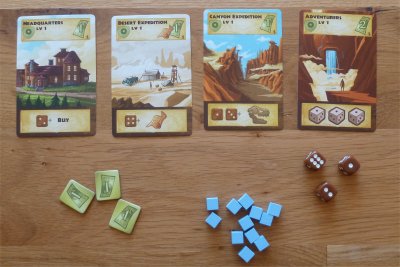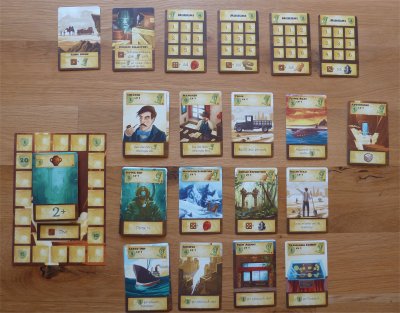

![[IMAGE]](../bilder/artinc1.jpg) |
Author: Publisher: No. of Players: |
![[IMAGE]](../technik/box/rot/rot-4.gif) ![[IMAGE]](../technik/box/gelb/gelb-7.gif) ![[IMAGE]](../technik/box/grun/grun-4.gif) ![[IMAGE]](../technik/box/pink/pink-7.gif) ![[IMAGE]](../technik/box/blau/blau-7.gif) |
|
Artifacts Inc. offers a bit of an Indiana Jones flair, since the players take control of archeologist companies in the 1920's, trying to become most famous by digging up the most spectacular items. Each player starts the game with some money and 4 playing cards: his Headquarters, two different Expeditions, and an Adventurers-card (granting him 3 dice for actions). These cards will be aligned in a row in front of the player to represent his company's assets, and in the middle of the table an open display of three rows of additional Asset cards will be revealed for the players' future purchases.
During his turn, a player will first roll his hand of six-sided adventurer dice. As indicated, the Adventurers card assigned during setup will grant him a hand of three dice, but during the game the players may spend money to hire additional Adventurers or even Archeologists in form of Asset cards, and these will grant additional dice. Depending on the results rolled, the dice can be used by the player to act on Asset cards of his company, and at the beginning of the game the available actions are the purchase of new Asset cards (using the Headquarters) or the search for artifacts (using Expedition cards). Actions are dealt with in a rather straightforward manner, since the purchase of a new asset allows the player to chose a card from the common display, pay for it and then add it to his company's assets. If a dice is used for an expedition, the player simply takes one of his coloured playing pieces and places it onto the Expedition card, marking that the expedition has found an artifact.
 Apart from acting on his own company's Asset cards, a player also may use his dice for acting on some public action cards. Most prominent among these cards are the four museums which will buy artifacts coming from the four different types of expeditions. Each of the four museum cards has an order list for different quantities of artifacts, and if the active player can meet one of these orders he may place a fitting dice at the museum in order to sell the required number of artifacts. The order then will be marked with one of his playing pieces, and in the final scoring each of the museums will be evaluated to see which player has fulfilled the most orders, giving these players an end-game bonus. For the time being, the player will only gain some money, but this will come in quite handy to acquire better assets. By the way, some money also can be gained by assigning dice to work as a tourist guide or by selling artifacts to private collectors, but these actions will do not provide any scoring possibilities. As a final action, a player also may assign one or more of his dice to go on a dive, searching for valuable discoveries in the depths of the sea. At the beginning of the game a deck of Dice cards has been prepared, sorting the cards by an ascending difficulty level. The difficulty level of each Dive cards denotes the total value of the dice which a player needs to spend in order to collect the Dive card, and so the players will need ever higher results in order to claim a still available Dive card. In the end-game scoring, each Dive card will count for one additional Victory Point. The game gets quite tricky due to three special features associated with the Artifact cards. On the one hand, especially the more expensive Assets which are commonly available will grant additional victory points for collecting certain other cards. For example, there exist three different types of Dive cards (Doubloons, Sunken City, Pottery) which come up in alternating order, and some of the available Asset cards will grant additional Victory Points for a specific type of Dive cards. Other Asset cards actually provide additional Victory Points if they have been placed next to certain other cards, e.g. the Cargo Ship will provide Victory Points for every adjacent Expedition card, and so these cards actually enrich the game by a minor card placement mechanism. As indicated, the four Asset cards assigned to the players during setup will be placed in one row in front of the player, but every further Asset card purchased by the player now needs to be placed next to one of the other Asset cards. Up to two card rows may be established in this fashion, and so a player needs to think carefully which cards he might still want to buy in order to maximize his possibilities for an additional scoring. On the other hand, this also brings up a timing issue, since a player cannot count on the fact that a card will still be available for purchase when he is ready to do so - a competitor might have snatched the card away… The third specialty of all Asset cards is the fact that these can be upgraded using the action provided by a player's Headquarters. If a player decided to upgrade an asset, he has to pay the purchase price of the card once again, allowing him to turn the card onto its other side. As a general rule, the action or scoring option provided on a card's backside is better than on its frontside, and so the players will strive to upgrade as many assets as possible. Concerning the game's playability, this proverbial double-sidedness of the cards requires especially new players to check out the Asset cards before the game begins, since a good handling of the available upgrades certainly is one of the keys to do well in this game. From a player's perspective, it might have been helpful if the cards' frontsides had a small icon displaying their upgraded features, but due to the manageable total amount of Asset cards it's still possible to learn the upgrade features rather quickly.  During the game the players will gain Victory Points by acquiring/upgrading Asset cards and by collecting Dive cards, and the game ends when the first player has accumulated 20 or more Victory Points. In a final evaluation additional points will be assigned for museum majorities and certain assets, and player who has collected most points will be granted the title of "Most Famous Archaeologist". Whereas Artifacts Inc. on first sight may seem to be a typical dice placement game, Ryan has worked a number of features into the game which give Artifacts Inc. a very special flair. On the one hand, each player has some control over the actions and scoring options available to him due to the Asset cards he decides to purchase, and on the other hand some elements of typical tile placement games have been included due to the trait of some Asset cards which allows a scoring for adjacent other cards. Quite interestingly, the randomness caused by rolling dice and using them for actions is not as high as it might be expected, and this is due to the combined actions offered by a player's own assets and the public action cards. In most cases a player will find a sensible use for his dice, and so only a player with really bad luck all during the game will really be hindered by dice results from implementing his strategy. At the beginning of this review I have stated that I am quite fond of tactical dice games if they are well designed, and from my perspective Artifacts Inc. certainly falls into this category. The players need to tackle a number of factors in order to manage their companies successfully, and an interesting competition between the players is created by the fact that everyone strives to get the best assets at a time which allows best scoring possibilities. Even though the combination of dice rolling and a "tile placement" mechanism is unusual, Ryan has solidly combined these mechanisms into a quite likable little game. And, like all games coming from RED RAVEN GAMES, Ryan's artwork once again is a unique trait of the game! | ||
|
| ||

|
|

|
|
| ||
|
Impressum / Contact Info / Disclaimer Kulkmann@aol.com
Copyright & copy; 2015 Frank Schulte-Kulkmann, Essen, Germany | ||